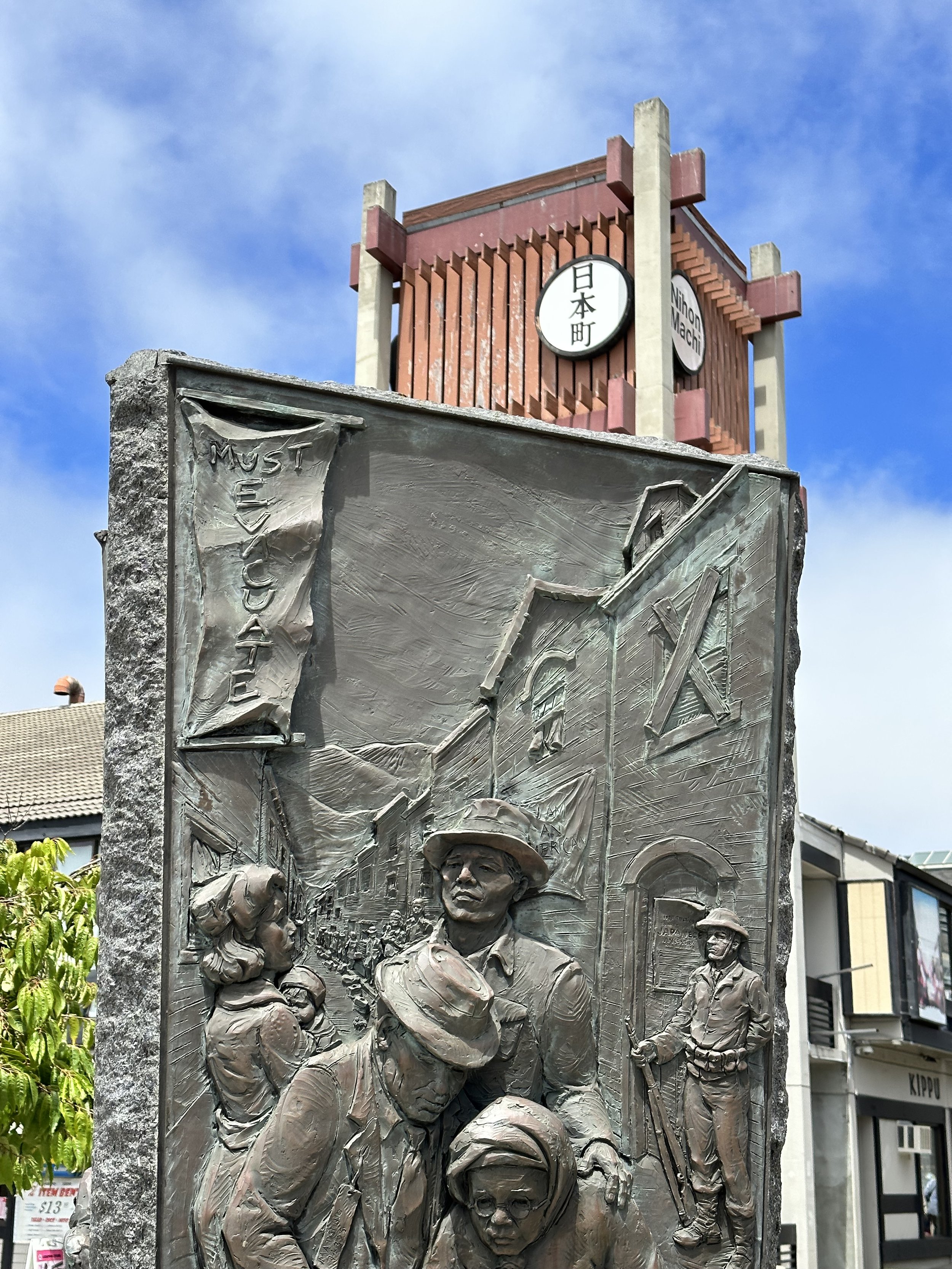Redevelopment
“Fix Our Cities!”
While the Fillmore flourished as a rare, diverse space in a largely segregated city, life still wasn’t easy. Thousands were left unemployed as the war-time jobs vanished. Most of San Francisco’s organized labor unions continued racist policies that kept people of color out of permanent industrial jobs, preventing Black workers from laying a foundation to climb the economic ladder when the war ended. Unemployment sent the crime rates up. The gingerbread Victorians were shabby, falling apart with bad plumbing, and stretched to the point of overcrowding. Many families lived on top of their businesses, which was convenient, but looked “messy” to the city officials who were starting to come inspect the neighborhood. To them, extreme overcrowding and unsanitary plumbing infrastructure were social and health hazards, not consequences of decades of racist housing policy…
Gangsters had frequent clashes with the police, who were increasingly being called to the bars and nightclubs. To the people that lived there, it was a vibrant community, the heart of San Francisco’s jazz heyday just breathing to life. But outsiders looked at the poor, non-white neighborhood - and they pronounced it a “slum.” A cry was heard across post-war America to clean up cities, and the answer came in two words: Urban Renewal.
The Omnibus Housing Act of 1949 provided federal funding for “slum clearance,” attempting to reverse the middle-class flight to the suburbs. One and a half billion dollars were allocated for the renewal of “blighted,” inner city areas. Since older inner-city buildings and storefronts on the margins of downtown were often the only areas where immigrants, minorities, and the low-income could settle, ethnic and non-white neighborhoods were specifically targeted for this redevelopment throughout the country. In San Francisco, city planners drew a big red box around the Western Addition.
“I met the mayor. He said: ‘Mr. Fleming, how long do you think these colored people are going to be here?’ And I said, ‘Mr. Mayor, you know how permanent the Golden Gate is out there? Well the Black population is just as permanent…because we don’t need a passport to come here. We’re American citizens!’”
–Thomas Fleming, KQED Neighborhoods Documentary
Cover, 1947 City Planning Commission report. (Archive.org)
Bulldozed
The San Francisco Redevelopment Agency was created in 1948, though for more than a decade plans for the neighborhood stagnated in politics and paper shuffling. It was a crucial delay, because, in that span of those ten years, the neighborhood—tossed together by war—put down roots, flourishing as the “Harlem of the West.”
The first house was bulldozed in 1953, kicking off “Western Addition Project A-1.” 28 blocks were demolished for the Geary Expressway: a submerged six lane boulevard facilitating the downtown auto commute from the Richmond District, which effectively cut Nihonmachi and the Black Fillmore in two. Eight thousand residents were displaced and 6,000 units of low-cost housing destroyed. Only 2,000 new units were built, and only one third was affordable housing.
In 1963, a second redevelopment plan for the Western Addition was announced. Phase A-2 encompassed nearly 60 square blocks, affecting more than 13,000 Fillmore residents. By now, with much of the neighborhood under redevelopment, many of the businesses and nightclubs began to move to other neighborhoods or closed altogether. By this point, along with many other residents of Japantown, Daisy, her daughter Caroline, and the rest of the family had moved out to the Sunset.
By the time the bulldozers fell silent, 883 businesses had been closed, 20,000 to 30,000 residents displaced, and 2,500 Victorian houses demolished. All this meant Japantown was no longer a place for residences and local businesses; most of that was moved to make way for the new “Japanese Culture and Trade Center.” The heart and soul of Black San Francisco was also torn out from the Fillmore.
Aerial view of the Western Addition A-1 redevelopment zone in 1954. Photo: San Francisco History Center, SF Public Library,
Western Addition Area 1 demolition, December 1953. (via SFPL)
The Fight Back
Facing the destruction of their community, the residents of the Western Addition organized. In the summer of 1948, a meeting was held at the Buchanan Street YMCA that drew more than 300 residents. Community leaders such as Dr. Carlton Goodlett, president of the San Francisco chapter of the NAACP, and Mrs. Michi Onuma, publisher of the Progressive News, spoke out against the project, clairvoyantly expressing that “no guarantees have been provided that new housing built in the area will not be priced out of the range of the average worker living there,” and that “scores of small businessmen would be wiped out by the plan.”
In 1967, in the wake of the bulldozering, a coalition formed the Western Addition Community Organization (WACO). They picketed the SFRA, organized, and blocked bulldozers. Citizens Against Nihonmachi Eviction (CANE) was formed in 1973 to fight against the eviction of small businesses and low-income folks by corporations. CANE’s work for tenant rights brought certain eviction decisions made by the SFRA under scrutiny, though only small concessions were made. WACO won some legal battles, managed to delay redevelopment, and got additional housing built, but–by and large–it was too little, too late.
Courtesy of digitalSF.org
Today, Japantown is centered on the Peace Pagoda, which memorializes the neighborhood’s earlier struggles with internment, but primarily caters to businesses and tourists. Credit: Katy Long
Leola King had arrived in San Francisco from Oklahoma in 1946, at the age of 27. A real go-getter, she became one of the first Black female business owners in the city, starting a wildly popular barbecue joint in the Fillmore called Oklahoma King's. In the early days of redevelopment, she began to be regularly approached by the SFRA. She warded them off, insisting multiple times that the restaurant was not for sale. But, one morning when she arrived to open up, she was greeted by a bulldozer and a ripped-up lot where Oklahoma King's used to be.
Sarah Vaughan, who sang at opening night on Bop City in 1949. Credit: William Gottleib, Public Domain
"They just come in and bulldoze it to the ground. Took all my equipment, stuff that I’d paid for, and all of my foods and everything. I don’t know what happened to anything. When I go there, the lot is clear; there’s nothing on it. So that made me have to go to the hospital. I just was so upset." —Leola King
She was later reimbursed what she'd paid for the lot, but not the building, equipment or business expenses—in all receiving a small fraction of what Oklahoma King's was actually worth. Nevertheless, she rallied after this first loss and opened the Blue Mirror Cocktail Lounge in 1953. The spot became famous for hosting jazz greats like Louis Armstrong and Dinah Washington. Like virtually everyone in the neighborhood at that time, King rented the building. Redevelopment again reached her business in the early 60s, and she was kicked out with no compensation.
Two more commercial and residential properties she owned in the neighborhood were also eventually taken by the SFRA. The last time, she was forcibly removed by the sheriff. She spent the next 25 years fighting for just compensation and declared bankruptcy in the late '90s, losing her house. She passed away in 2013, never winning the decades-long legal battle for repayment.
1960 Post
Bop City closed its doors in 1965, as the music scene and the surrounding neighborhood was, by that time, devastated by the SFRA’s actions. By the late 1970s, the Queen Anne Victorian at 1690 Post was slated to be razed. However, through combined efforts of neighborhood historians and activists, the building itself was rescued from demolition; along with five other Victorians, it was picked up and moved two blocks to 1712 Fillmore Street.
Marcus Books, the oldest African American bookstore in the United States, was founded in 1960 in the Fillmore by Drs. Julian and Raye Richardson. As redevelopment swept the neighborhood, the family-owned bookstore was forced to relocate several times before landing, in 1981, in the building that once housed Nippon Drugs and Jimbo’s Bop City. Co-owner Karen Johnson (Julian and Raye’s granddaughter) said that they were “the only Black business that returned to the Fillmore.”
In 2014, the Johnsons, upon failure to pay rent, were unceremoniously evicted, locked out of their store by the building’s new landlords. The space now operates as an upscale hair salon.
What had been pitched as “urban renewal” in the 1940s was re-christened by writer James Baldwin—whose pointed critiques of American democracy and race undoubtedly lined the shelves of Marcus Books—as “Negro removal.” More than half a century later, the cycles of racism, gentrification, and displacement continue.
Fillmore Jazz Festival, 2020. Despite the closure of many venues as a result of redevelopment, jazz remains an important part of the Fillmore neighborhood’s legacy. Credit: Thomas Hawk, CC BY-NC 2.0 DEED.
Want to Learn More?
Take this Hammer, a documentary film on James Baldwin’s 1963 visit to San Francisco
Nihonmachi and Urban Renewal, Shizue Seigel. Nikkei Heritage, v. XII, no. 4 (Fall 2000/Winter 2001)
How ‘Urban Renewal’ Decimated the Fillmore District, and Took Jazz With It
Jackson, C., & Jones, N. (2012). Remember the Fillmore: The lingering history of urban renewal in Black San Francisco. UCSB Center for Black Studies Research.
Fillmore Revisited — How Redevelopment Tore Through the Western Addition
Leola King - Oral History
Marcus Books, the Nation’s Oldest Black Bookstore








